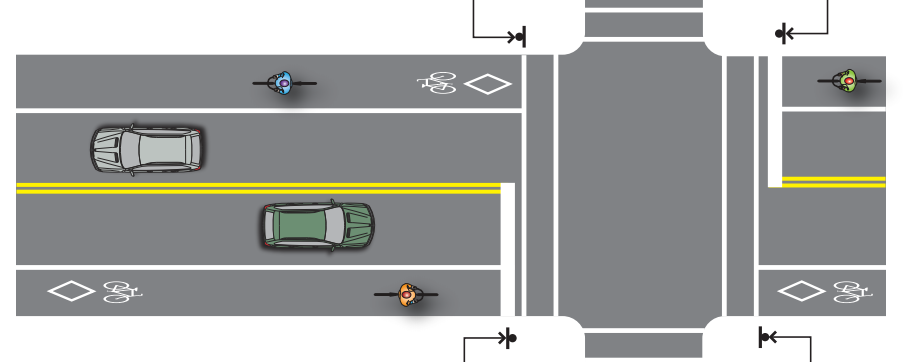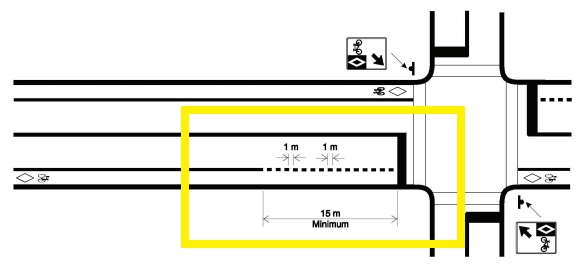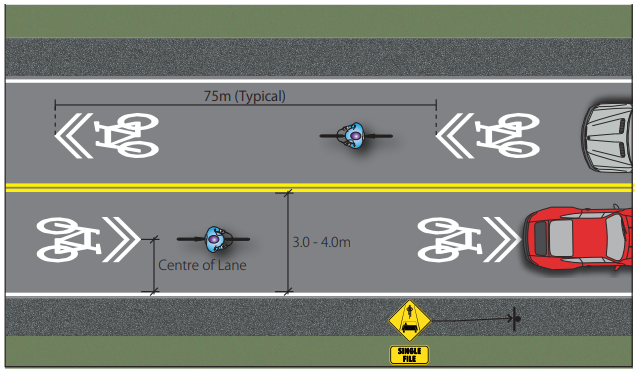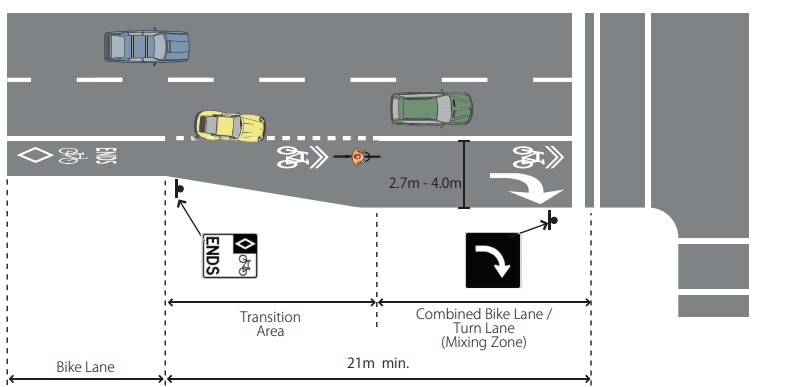
Sarnia is a great City to explore by bike, whether cycling along the river, the Howard Watson Trail, or on our City streets, there are many safe and enjoyable routes. The City’s Official Plan and Transportation Master Plan emphasize our commitment to enhancing safe active transportation routes in our community. Developing our active transportation infrastructure will make our resident’s healthier and our community more livable. The following information is provided to help you understand how to use our cycling infrastructure whether you are riding your bike or driving your car.
Bike Lanes
On street bike lanes, designated by line painting and signage, provide a safe space for cyclists. They separate vehicles and bikes, reducing the need for vehicles to pass cyclists, and they reduce the number of conflicts with cyclists. Many people who want to cycle are nervous riding on the road with traffic and will only do so if a safe space, like a bike lane, is provided.

Regular vehicles are restricted from driving, stopping, or parking in a bike lane. When turning across a bike lane it is important to ensure that there is no cyclist in the way. If an emergency vehicle is travelling down the road, a driver is allowed to move into the bike lane to provide sufficient space for the emergency vehicle to proceed, after checking to ensure there is no cyclist in the way. City buses, garbage trucks, and other service vehicles making short duration stops are allowed to block the bike lane. Cyclists can either stop and wait in the bike lane behind the service vehicle, or when safe, pass the stopped vehicle in the vehicle lane.
E-Bikes
In Sarnia, E-bikes are allowed to ride in the bike lanes. Some municipalities do have by-laws restricting E-bikes from using bike lanes. For more information visit the MTO website.
Right Turns
At intersections the solid white bike lane turns into a dashed line. This is to indicate to drivers that they can cross over the bike lane to make a right turn, after first ensuring there is no cyclist in the lane. The dashed line also indicates to cyclists that a vehicle may cross over the bike lane in this area. If a cyclist comes upon a vehicle blocking the bike lane to make a right turn, they should wait behind the vehicle or can pass on the left, if safe to do so.

Share the Road
Cyclists can bike on all City streets and vehicles must share the road. When passing a cyclist, a driver must ensure there is at least 1m of space between their vehicle and the cyclist. Some streets on designated bike routes will have a sharrow, a bike symbol with two arrows, painted in the vehicle lane. These are intended to remind drivers to watch out for cyclists and they indicate where the cyclist should ride. If the lane is wide enough for vehicles and cyclists to ride side-by-side the sharrow will be located at the side of the road, if there is not room for vehicles to pass a cyclist with 1m of clearance then the symbol will be painted in the middle of the lane. In these situations, cyclists should bike in the centre of the lane, it is better to bike there and force vehicles to drive behind you than to try to squeeze to the side of the road and allow drivers to think it is ok to pass without the 1m minimum separation.

At some intersections, like Capel/Exmouth, the bike lane ends and merge into the right turn lane. These locations are marked with a right turn arrow and a sharrow symbol (bike with two arrows). At these locations vehicles planning to turn right must ensure the path is clear before moving into the right turn lane, these vehicles must then turn right. Cyclists will leave the bike lane and continue travelling on top of the sharrows. The cyclists can either proceed straight through the intersection in that lane or turn right. This layout is used when a right turn lane is required due to the volume of vehicles at the intersection, where there is insufficient room to also keep the bike lane, and where there is a bike lane on the other side of the road. The benefit of this layout is at busy intersections where the cyclist is separated from the faster through traffic and does not have vehicles turning right in front of their path.

Green Lanes and Green Box
In areas where high volumes of traffic will cross a bike lane they are sometimes painted green to provide additional notice to drivers to be aware of cyclists. At some intersections, where there is a large number of cyclists turning left, the green box will be painted across all lanes of traffic. In this case, drivers must stop behind the green box at a red light. Cyclists are allowed to cycle to the front of the bike lane and move to the left lane in front of the vehicles in the green box. If a vehicle wants to turn right on a red light they would first stop behind the bike box and then proceed to move forward and make the right turn after confirming there are no cyclists.

Cycling on Sidewalks
Cycling on sidewalks is prohibited if the diameter of your bike tire is larger than 50cm. This rule is intended to restrict cycling on sidewalks to children. Cycling on sidewalks is dangerous because drivers turning in and out of side streets or driveways are not anticipating someone moving at the rate of speed of a cyclist on the sidewalk. Often sight lines of the sidewalk from driveways or side streets is not sufficient to see someone moving at the rate of speed of a cyclist.
Multi-Use Trail Road Crossings
There are a number of multi-use trails in the boulevard around the City, like the one on Wellington Road by Clearwater Arena. These off-road trails are well suited to areas of the City with minimal driveway and road crossings. At intersections these trails cross the road using the crosswalk. Cyclists using these trails need to stop at the intersection, dismount from their bike, and walk across the intersection. Drivers are not expecting someone moving at the rate of speed of a cyclist going through the crosswalk.
Taking your Bike on the Bus
All Sarnia Transit buses are equipped with bike racks to encourage environmentally friendly, active transportation that combines the benefits of cycling with the convenience of cycling. Visit the Bike Racks on Buses page for more information.
Bicycle Friendly Community
In the Spring of 2018, Share the Road Cycling Coalition facilitated a Bicycle Friendly Communities Workshop. The stakeholder workshop and community engagement session generated ideas for how Sarnia can become a more bicycle friendly community. A brief summary report and a detailed report with a list of recommendations was developed. These action items have been delegated to various City committees to implement.
Additional Resources
For more detailed information on how to cycle safely refer to the Ministry of Transportation’s Cycling Skills Handbook.
Visit Bicycle-Friendly Lambton for safety tips, Sarnia cycling maps, events and much more.